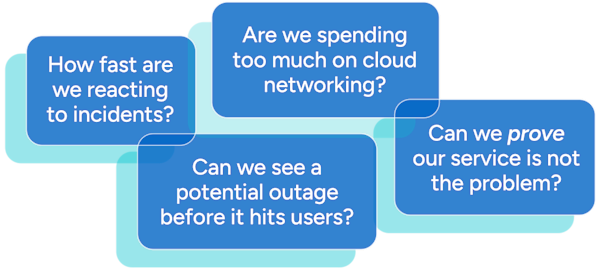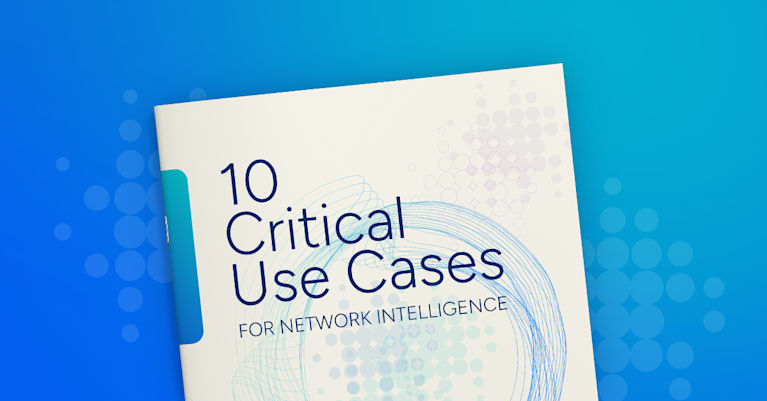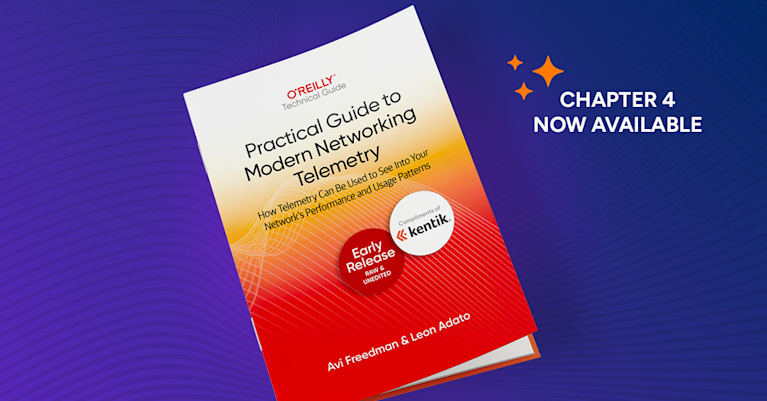Beyond Observability: Why Network Intelligence Will Make Traditional Network Management Obsolete


Summary
Kentik CEO and co-founder Avi Freedman explains why observability is not enough in the age of AI.
When we started Kentik, we were witnessing something remarkable in the world of application development: a tooling revolution. App teams were suddenly empowered with platforms that understood them. Tools that didn’t just ingest telemetry, but spoke the language of developers. They embedded seamlessly into workflows, surfacing insights before anyone even thought to ask the question. They made developers faster, better, more confident. It was a new world.
That’s been our vision at Kentik — but for network engineering, cloud, and infrastructure teams.
We started with the belief that networks are too critical to fly blind. That telemetry from routers, switches, firewalls, CDNs, cloud providers, and the internet was the richest untapped source of intelligence in infrastructure. So we built a platform that could make sense of it all. With network observability, we gave network teams a real-time, contextualized, full-fidelity view of everything.
It’s been a journey of empowering networkers by letting them ask any question of their networks.
But now, something bigger is needed.
Companies need (and executives want) more
Executives have felt the acceleration across the business. Now they’re asking the hard questions of infrastructure and network teams:

These are not IT questions — they’re business questions. Because uptime, speed, and cost now impact every part of the company, from customer experience to margins.
Networks power all digital communications, but networking is complex.
Until now, network insights have been limited to experts with years, if not decades, of experience. We’ve been proud to build critical tools for these folks. But they are pulled in many directions, supporting network, application, finance, and security teams, making it difficult to apply their unique skills to strategy and optimization.
We need to unblock experts and empower every engineer — regardless of background — with the network context to answer complex questions.
Modern AI has arrived
We’re standing at the edge of a new frontier, thanks to the revolution in modern AI. What used to require specialized teams, labeled data, and months of modeling can now be done in days, if not minutes.
- Foundation models understand language and intent.
- Vector databases enable semantic search across massive data streams.
- Autonomous agents can reason, plan, and take actions across systems.
These aren’t science projects anymore. They’re real, usable tools, and they’re transforming domains across the stack.
If your org doesn’t have an AI mandate yet, it’s imminent.
But generic AI tools aren’t built for network problems.
Network teams have been let down by AI
So many AI promises have fallen flat for network teams. Anomaly alerts that flood the inbox but don’t answer “why.” AIOps that de-duplicates and correlates alerts, but doesn’t explain or help you fix the issue.
Yes, modern LLM-based AI is exciting. But it’s also mostly blind to the complexities of infrastructure.
The generic AI copilots and observability add-ons weren’t built with a deep understanding of networking. They weren’t trained on traffic telemetry. They’ve never seen a BGP flap, or tried to figure out why an MPLS circuit randomly blackholed 25% of traffic for 30 minutes.
They’ve been trained with release notes but not architectures. And LLM-based approaches don’t have the context windows and memory to directly process the scale of modern network telemetry.
So networkers did what they do best: stayed skeptical. Rightfully so.
Now, that’s changing.
What’s needed: Network intelligence
Network intelligence isn’t about making the network smarter or about replacing people. It’s about making people more effective.
Now, any engineer — even the front lines and those without a deep understanding of the network — can solve issues, plan capacity, reduce costs, and keep systems secure so that companies can innovate faster and scale applications with confidence.
But what about network experts with years of experience? They can now move ten times faster.
The key is combining modern AI techniques with the power of observability to allow everyone to operate as an expert, and experts to be even more efficient.
Together, you can:
- Ask any question, get a contextual answer. From traffic, routing, performance, and metrics, across on-prem and cloud infrastructure.
- Predict problems. Teams need to get ahead of performance, hardware, capacity, and cost issues before they occur.
- Diagnose instantly and in natural language. Don’t waste cycles correlating across tools. Just ask: “Why is traffic to Ashburn slow from the West Coast?” and get the answer with the root cause.
- Automate troubleshooting. With an agentic framework, computers can perform hundreds of troubleshooting workflows and operate the observability systems the way human experts do.
- Monitor more widely. Instead of throwing away alerts and incidents, automated troubleshooting can determine which signals point to real issues, and surface those with recommendations.
- Do this all continually and proactively. All the above needs to happen before customers are affected.
Or, to summarize: Observability lets you ask anything. Intelligence gives you the answer and makes recommendations.
This isn’t hypothetical. It’s what we’ve been making real over the last year at Kentik.
What is network intelligence?
Network intelligence delivers automated insight and resolution to ensure networks deliver applications at scale. It combines AI with network observability that turns raw telemetry (flows, routing, device and cloud metrics, logs, synthetics) plus business context into answers and actions. It correlates and explains issues, predicts risk (like SLA breaches), and can trigger remediation across on-prem, multi-cloud, and hybrid networks.
Kentik’s vision for network intelligence encompasses flows, routing, SNMP and cloud telemetry, contextual enrichment, and natural-language workflows — it empowers teams and enables everyone from SREs to security teams to cloud engineers to understand the network.
How is network intelligence different from AIOps?
AIOps focuses on signal correlation — often ignoring the depth of modern observability platforms.
It’s time to move beyond noise reduction.
Instead of discarding data, we should learn from how experts use observability to engineer, operate, and troubleshoot.
Many network operations workflows require additional troubleshooting using observability systems. AIOps-based approaches struggle there because they only examine signals they’ve received, and don’t keep full-fidelity data.
Network intelligence changes that.
It uses AI to operate observability systems directly — just like a human.
What’s required to get there?
To achieve network intelligence, we need three things:
- A modern, agentically-accessible observability platform with full-fidelity network data and context. This means flow, SNMP, streaming telemetry, BGP, cloud, routing, performance, and beyond. It needs to be able to see, contextualize, and correlate any type of telemetry; and ask the same questions humans do about availability, performance, capacity planning, cost, and security.
- Network knowledge from builders and customers. Understanding key network use cases and how human experts use observability to architect, engineer, troubleshoot, and operate is key. That can be done in partnership with those experts directly, and by building automation, insights, and workflows that represent the best practices of how modern observability systems are used.
- An agentic framework to automate planning, engineering, operations, and troubleshooting. With a great and open observability platform and the use cases in hand, an agentic framework can run queries and respond to alerts, triggering agentic investigations that interact with both other platforms and engineers to provide recommendations, automate monitoring, and resolve issues.
Learn how AI-powered insights help you predict issues, optimize performance, reduce costs, and enhance security.

Integration: Network intelligence and agentic AI
Leading companies run the digital world on Kentik — historically via UI and APIs. But now, we’re enabling agentic operation of Kentik itself — orchestrating AI agents to execute real-world planning, operations, and troubleshooting workflows across architecture, engineering, and operations.
We also know customers need multiple best-in-class platforms to work together.
That’s why we’re already being used agentically today — via authenticated APIs, accepting natural language instead of JSON. And as the MCP and A2A ecosystems mature, we’ll extend out APIs with metadata and examples to allow customers and partners to even more easily and widely leverage network intelligence.
The AI hype is real — and being adopted.
We’re building for it with customers and partners, with continued rapid innovation ahead.
Network intelligence is already here
Network observability gave teams the ability to answer any question about their network.
Network intelligence suggests the right questions, surfaces answers, and offers next steps.
Having machines help us use observability to surface relevant issues and causes will massively drop MTTI and MTTR, increase efficiency, and democratize network understanding. Teams will make better, faster infrastructure decisions, and allow humans to focus on what we’re best at.
We’re delivering the first stages of this now, with machine-assisted troubleshooting reducing MTTI and MTTR for some of the world’s largest enterprises and networks. Later this year, we’ll be releasing agentic orchestration of the common observability and operations workflows to fundamentally change how networks are managed.
Join us on our journey
We can’t do this without you.
Let’s talk about your key use cases and workflows, so we can build this together — and help your company’s AI strategy succeed.


